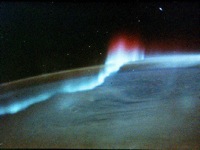Difference between revisions of "Auroras"
(Created page with 'File:lighterstill.jpgright|frame '''Auroras''', also known as northern and southern (polar) lights or aurorae (singular: aurora), are natural...') |
m (Text replacement - "http://" to "https://") |
||
| (One intermediate revision by one other user not shown) | |||
| Line 1: | Line 1: | ||
[[File:lighterstill.jpg]][[File:AuroraShuttle.jpg|right|frame]] | [[File:lighterstill.jpg]][[File:AuroraShuttle.jpg|right|frame]] | ||
| − | '''Auroras''', also known as northern and southern (polar) lights or aurorae (singular: aurora), are [[natural]] [[light]] displays in the sky, usually [[observed]] at night, particularly in the [ | + | '''Auroras''', also known as northern and southern (polar) lights or aurorae (singular: aurora), are [[natural]] [[light]] displays in the sky, usually [[observed]] at night, particularly in the [https://en.wikipedia.org/wiki/Geographical_pole polar regions]. They typically occur in the [https://en.wikipedia.org/wiki/Ionosphere ionosphere]. They are also referred to as polar auroras. This is a misnomer however, because they are commonly visible between 65 to 72 degrees north and south latitudes, which would place it in a ring just within the Arctic and Antarctic circles. Aurorae occur deeper inside the polar regions, but these are infrequent occurrences, and these are often [[invisible]] to the naked eye. |
| − | In northern latitudes, the [[effect]] is known as the ''aurora borealis'', named after the [[Roman]] goddess of dawn, [ | + | In northern latitudes, the [[effect]] is known as the ''aurora borealis'', named after the [[Roman]] goddess of dawn, [https://en.wikipedia.org/wiki/Aurora_(mythology) Aurora], and the [[Greek]] name for the north wind, [https://en.wikipedia.org/wiki/Anemoi Boreas], by [https://en.wikipedia.org/wiki/Pierre_Gassendi Pierre Gassendi] in 1621. The ''aurora borealis'' is also called the northern polar lights, as it is only [[visible]] in the sky from the Northern Hemisphere, with the [[chance]] of visibility increasing with proximity to the [https://en.wikipedia.org/wiki/North_Magnetic_Pole North Magnetic Pole]. ([[Earth]]'s is currently in the arctic islands of northern Canada.) Auroras seen near the magnetic pole may be high overhead, but from further away, they [[illuminate]] the northern [[horizon]] as a greenish glow or sometimes a faint red, as if the sun were rising from an unusual direction. The Aurora Borealis most often occurs near the [https://en.wikipedia.org/wiki/Equinox equinoxes]. The northern lights have had a [[number]] of names throughout [[history]]. The [https://en.wikipedia.org/wiki/Cree Cree] call this [[phenomenon]] the "Dance of the Spirits." In the [https://en.wikipedia.org/wiki/Middle_Ages Middle Ages] the auroras have been called a sign from [[God]] (see Wilfried Schröder, Das Phänomen des Polarlichts, Darmstadt 1984). |
Its southern [[counterpart]], the aurora australis or the southern polar lights, has similar properties, but is only [[visible]] from high southern latitudes in Antarctica, South America, or Australasia. Australis is the [[Latin]] [[word]] for "of the South." | Its southern [[counterpart]], the aurora australis or the southern polar lights, has similar properties, but is only [[visible]] from high southern latitudes in Antarctica, South America, or Australasia. Australis is the [[Latin]] [[word]] for "of the South." | ||
| − | Auroras can be spotted throughout the world and on other [[planets]]. It is most visible closer to the poles due to the longer periods of [[darkness]] and the [[magnetic]] field.[ | + | Auroras can be spotted throughout the world and on other [[planets]]. It is most visible closer to the poles due to the longer periods of [[darkness]] and the [[magnetic]] field.[https://en.wikipedia.org/wiki/Aurora_%28astronomy%29] |
[[Category: Astronomy]] | [[Category: Astronomy]] | ||
[[Category: Earth Science]] | [[Category: Earth Science]] | ||
Latest revision as of 23:41, 12 December 2020
Auroras, also known as northern and southern (polar) lights or aurorae (singular: aurora), are natural light displays in the sky, usually observed at night, particularly in the polar regions. They typically occur in the ionosphere. They are also referred to as polar auroras. This is a misnomer however, because they are commonly visible between 65 to 72 degrees north and south latitudes, which would place it in a ring just within the Arctic and Antarctic circles. Aurorae occur deeper inside the polar regions, but these are infrequent occurrences, and these are often invisible to the naked eye.
In northern latitudes, the effect is known as the aurora borealis, named after the Roman goddess of dawn, Aurora, and the Greek name for the north wind, Boreas, by Pierre Gassendi in 1621. The aurora borealis is also called the northern polar lights, as it is only visible in the sky from the Northern Hemisphere, with the chance of visibility increasing with proximity to the North Magnetic Pole. (Earth's is currently in the arctic islands of northern Canada.) Auroras seen near the magnetic pole may be high overhead, but from further away, they illuminate the northern horizon as a greenish glow or sometimes a faint red, as if the sun were rising from an unusual direction. The Aurora Borealis most often occurs near the equinoxes. The northern lights have had a number of names throughout history. The Cree call this phenomenon the "Dance of the Spirits." In the Middle Ages the auroras have been called a sign from God (see Wilfried Schröder, Das Phänomen des Polarlichts, Darmstadt 1984).
Its southern counterpart, the aurora australis or the southern polar lights, has similar properties, but is only visible from high southern latitudes in Antarctica, South America, or Australasia. Australis is the Latin word for "of the South."
Auroras can be spotted throughout the world and on other planets. It is most visible closer to the poles due to the longer periods of darkness and the magnetic field.[1]
